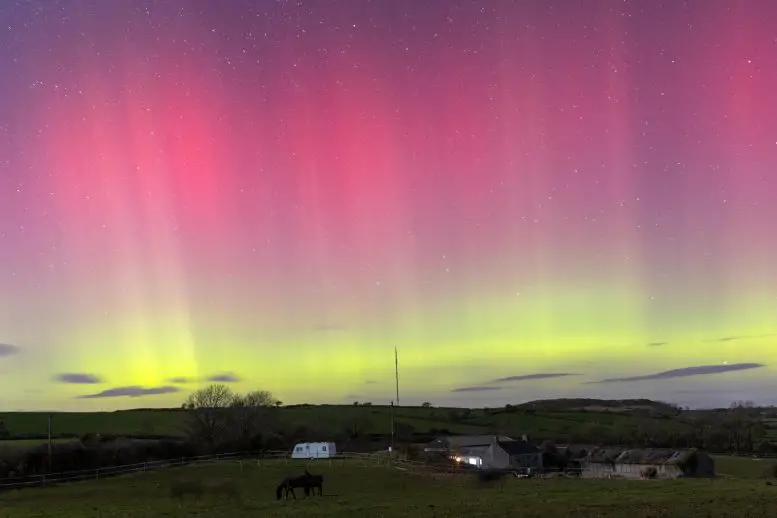Scientists have discovered that interplanetary shocks affecting Earth’s magnetic field are causing stronger electrical currents at ground level, threatening pipelines and undersea cables.
Auroras are caused by solar particles hitting Earth’s magnetic field, but these effects also cause geomagnetically induced currents that can damage infrastructure that conducts electricity at ground level. Scientists who study these currents to protect critical infrastructure have conducted the first study to compare interplanetary shocks with real-time measurements of geomagnetically induced currents, showing that the angle of impact of the shocks is key to predicting potential damage to infrastructure: shocks hitting the magnetic field at a certain angle create less powerful currents.
The impact of interplanetary shocks on infrastructure
For thousands of years, the aurora borealis has inspired myths and prophecies, but because of modern technology’s reliance on electricity, we are only now beginning to appreciate their true power. The same forces that cause the aurora borealis also cause currents that can damage infrastructure that transmits electricity, such as pipelines. The scientists now write Frontiers in Astronomy and Space Sciences, showed that the angle of impact of interplanetary shocks is important for the strength of the currents, making it possible to predict dangerous shocks and protect critical infrastructure.
“Auroras and geomagnetically induced currents are caused by similar factors in space weather,” explained the paper’s lead author, Dr. Danny Oliveira of NASA’s Goddard Space Flight Center. “The aurora borealis is a visual warning that electric currents in space may be generating geomagnetically induced currents on Earth.”
“The auroral region can expand significantly during severe geomagnetic storms,” he added. “Normally, its southernmost limit is at 70 degrees latitude, but during extreme events it can drop to 40 degrees or even lower, which was certainly the case during the May 2024 storm, the strongest storm in two decades.”
Light, color, action
Auroras are caused by two processes: Either particles ejected from the Sun reach the Earth’s magnetic field, causing a geomagnetic storm, or interplanetary shocks compress the Earth’s magnetic field. These shocks also create geomagnetically induced currents that can damage infrastructure that conducts electricity. Stronger interplanetary shocks mean stronger currents and auroras, but less frequent, powerful shocks can also cause damage.
“Perhaps the most devastating impact on power infrastructure occurred in March 1989, when a severe geomagnetic storm knocked out the Hydro-Quebec system in Canada for about nine hours, leaving millions without electricity,” Oliveira said. “But weaker and more frequent events, such as interplanetary shocks, can eventually pose a threat to grounding conductors. Our work shows that significant geoelectric currents occur quite frequently after shocks and deserve attention.”
Shocks that hit the Earth directly, rather than at an angle, are thought to cause stronger geomagnetically induced currents because they compress the magnetic field more strongly. Scientists have investigated how geomagnetically induced currents are affected by shocks at different times of day and at different angles.
To do this, they took a database of interplanetary shocks and compared it to readings of geomagnetically induced currents from a gas pipeline in Mäntselä, Finland, which is typically in the auroral region during an active period. They used data from the interplanetary magnetic field and solar wind to calculate properties of these shocks, such as their angle and speed. The aftershocks were divided into three groups: strong-dip aftershocks, moderate-dip aftershocks, and near-frontal aftershocks.
Angle of attack
They found that more foreshocks resulted in higher peaks in geomagnetically induced currents, both immediately after the shock and during the subsequent substorm. Intense peaks occurred particularly near the north of the magnetic field, when the north pole was between the Sun and the Miantsial. Local substorms at this time also caused spectacular auroras.
“As Mäntsiala approaches dusk local time, moderate currents occur shortly after the disturbance, while more intense currents occur around midnight local time,” Oliveira said.
Because the angles of these aftershocks can be predicted up to two hours before they hit, this information could allow us to put protections in place for power grids and other sensitive infrastructure before the strongest, most forward-moving aftershocks arrive.
“One of the things power infrastructure operators can do to protect their equipment is to operate multiple electrical circuits when an electrical shock warning is given,” Oliveira said. “This will prevent geomagnetically induced currents that shorten the life of the equipment.”
However, the scientists did not find a strong correlation between the impact angle and the time it took for the impactor to hit and then create a current. This may be because additional records of currents at different latitudes would be needed to investigate this aspect.
“The current data is only collected at one specific location, namely the Mäntsälä gas pipeline system,” Oliveira cautioned. “Although Mäntsälä is in a critical location, it does not give a picture of the entire world. In addition, the Mäntsälä data was missing for several days during the study period, forcing us to discard many events in our shock database. It would be great if energy companies around the world made their data available for scientists to examine.”













